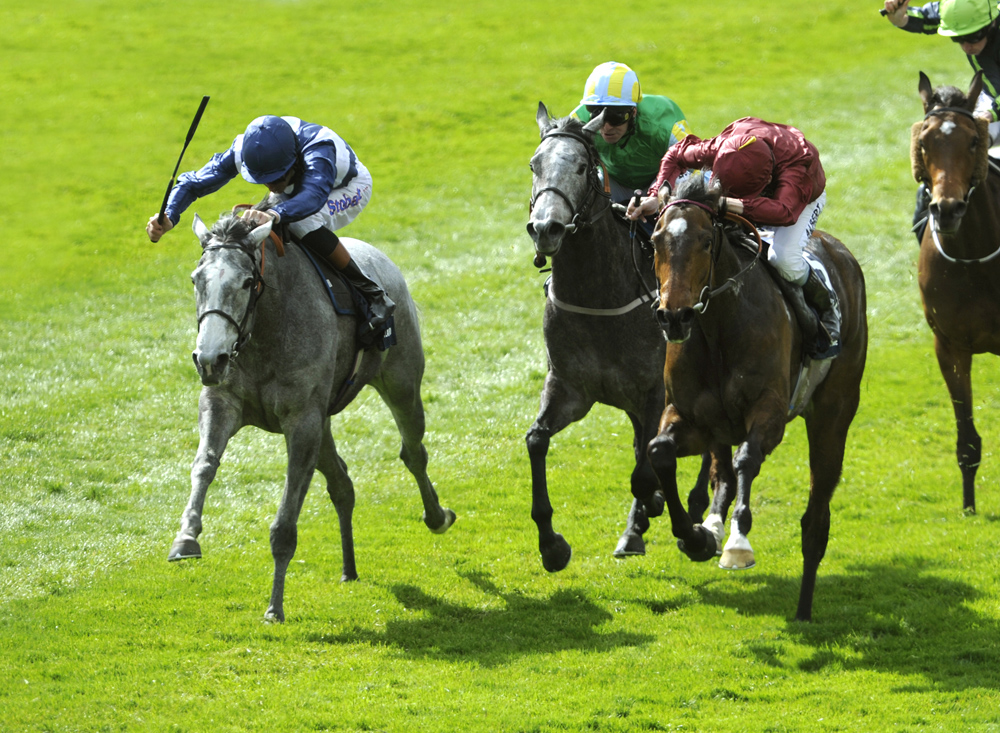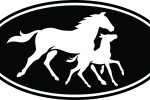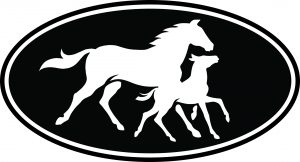It has taken only three years for SackvilleDonald to attain the prominence normally associated with long established outfits. Launched in 2011 by Ed Sackville and Alastair Donald, both of whom had previously worked for Kern/Lillingston Association, the Hungerford-based agency didn’t have to wait long for its first Classic winner when Sky Lantern, a €75,000 yearling purchase by Sackville on behalf of Ben Keswick, landed last year’s 1,000 Guineas en route to victories in the Coronation and Sun Chariot Stakes.
Her win opened a consistently successful season for SackvilleDonald, one which also celebrated Chriselliam, the ill-fated Fillies’ Mile and Breeders’ Cup Juvenile Fillies winner who was bought by Donald for 40,000gns, Singapore Airlines International Cup winner Military Attack, Canadian Group 1 winner Forte Dei Marmi and Turkish Group 2 winner Producer.
With Sky Lantern remaining in training with Richard Hannon and the likes of Military Attack and recent Hong Kong Derby winner Designs On Rome doing the agency proud already in Hong Kong this year, more of the same is already on the agenda for 2014.
SackvilleDonald has achieved a lot in a short space of time. How did the decision come about in 2011 to join forces?
AD: We both worked for Kern/Lillingston and were based together in the Hungerford office. So we had three years together in our office to get to know each other.
It was fortunate that when SackvilleDonald was set up, we didn’t have to change offices.
ES: It’s going really well. Obviously Sky Lantern had a great season last year after winning the Moyglare Stud Stakes at two and Alastair had Chriselliam.
But in all honesty it is really about the agency’s success, not the individual success.
At the end of the day the likes of Sky Lantern and Chriselliam were SackvilleDonald purchases as opposed to being bought by Ed and Alastair respectively.
How do you think you complement each other?
AD: We bounce ideas off each other – for example I may ask Ed’s opinion on a stallion. It’s good to have someone like-minded when you have a problem. We enjoy each other’s company and it’s important to have fun.
And at a sale like Tattersalls [October] Book 2, we can get round and actually look at every yearling as a team.
ES: Having the two of us allows us to be seen in most places, whether it’s Alastair in Hong Kong or myself in Deauville or Fairyhouse. There are also occasions when we work on a horse together.
Belle Royale [a Grade 1 winner] was an instance where it worked well. Demi O’Byrne approached me and Alastair sourced the horse.
She was quite a risk to put up – she was an £800 yearling with little pedigree and had never run in a stakes race before.
But Michael Tabor bought her on the advice of Demi O’Byrne, sent her to Simon Callaghan in the US and on her second start over there she won the Gamely Stakes.
How did you first become involved in horseracing?
AD: My father owned horses in syndicates and from about the age of seven I would watch racing on TV and go racing. I was in Ladbrokes most days when I was at Rugby.
I did an agricultural degree at Cirencester and went from there to work for Fasig-Tipton for a year.
I also worked the sales with Mark Johnston for a season and did a stud season at Darley before spending time with the Racing Post working in various departments.
After that I joined Kern/Lillingston, where I spent 11 years.
ES: My father had horses and I would watch the racing with him on TV. I remember going to Newbury and having a £2 bet on a 66-1 shot, which won.
I was on the first Darley Flying Start, a fantastic course. I now give them a lecture every year while a trainee will shadow me at Goffs and another does a month’s work experience with us.
I also worked for John Warren for nine years, starting from when I left school, and from there joined Kern/Lillingston.
Your time with Kern/Lillingston was obviously well spent…
AD: Luke taught me an awful lot yet gave tremendous free rein. He would have no trouble sending you around the world, which was great.
ES: He was a great stepping stone. He was quick to encourage and would instill tremendous confidence in you.
Which horses marked the turning point in your careers?
AD: Golden Apples [winner of the Del Mar Oaks, Yellow Ribbon Stakes and Beverly D Stakes], the Eclipse Champion grass mare of 2002. I used to go to the US during the first couple of years I was with Luke and walk around the backstretch to try to talk to trainers.
They’d give you 15 seconds of their time and you’d think, ‘What can I say to try and get them to buy a horse from Europe?’
After Golden Apples became an Eclipse Champion, I could drop her into conversation and that 15 seconds conversation was extended to two minutes!
ES: Sky Lantern has been a real flagship horse. But last year we also had Producer [winner of the International Topkapi Trophy at Veliefendi for Richard Hannon].
He’s a fun horse who wasn’t expensive at £28,000 and has now won £375,000 in prize-money.
Any other purchases that you are particularly proud of?
AD: Of course Chriselliam and it’s sad and frustrating that we’ll never know how good she was. I’m also particularly proud of Dim Sum, who raced as Algol over here.
He won the Chairman’s Sprint Prize in Hong Kong for John Moore. I bought him as a two-year-old at the DBS November Horses in Training Sale for £100,000, which is quite cheap by Hong Kong standards.
However, he was rated only 83 at the time. Muhannak wasn’t expensive and his win in the Breeders’ Cup Marathon was a real long-term plan that we pulled off.
ES: Brown Sugar, who won the Molecomb and Sirenia Stakes. He’s special as he’s owned by my father’s syndicate De La Warr Racing and was good value at €47,500.
Alastair, you have enjoyed immense success with horses bought to race abroad. How did that side of the business become established?
AD: Golden Apples was the one who changed everything as she was the first horse I bought for Gary Tanaka.
The first horse I bought to go to Hong Kong was Strong Scotch, who won a couple of Class 1s. Soon after, I got a connection with John Moore and bought my first horse for him, Goggles, in 2001.
He won a Group 3 out there and that got John’s taste coming to Europe. It was only two years later that we bought [multiple champion] Viva Pataca.
He was with Sir Mark Prescott [when named Comic Strip] and it was the year that Sir Mark had a virus and didn’t run many until July.
Viva Pataca had won five of six races at two, including a Listed race, and ran first time out in a premier handicap at Goodwood, in which he carried 10st.
He circled the whole field in what looked a winning move and then blew up. He was a tall, leggy horse by Marju, who had done well in Hong Kong and he went on to become Hong Kong’s all-time leading money earner.

Sky Lantern, left, provided the duo with a first Classic victory
The horses in training market has evolved significantly since then. What have been the major changes in that market and overall?
AD: The increase in the number of horses going down to Australia. They can be different types and there have been some extremely high priced horses.
The last five years have been a lot quieter in America. It’s become harder for them to buy the three-year-old Hollywood Derby type of horse because they get outbid by Hong Kong or Australia.
A lot of the horses now doing well out there are the cheaper types coming out of the horses in training sales.
There’s no doubt that the market is getting more competitive, due in part also to the emergence of Australia and Qatar.
In addition, the days of deals taking a couple of weeks are gone. Back then, you would have to sort through old copies of the Racing Post to find results you wanted, sometimes six races back, photocopy them and send them out on a DVD.
Now I can tell the buyer via text to watch the replay of a race and send photos and videos from my phone. So the whole process may take only a day.
ES: Having worked with Alastair, I have a clear idea of what will sell abroad down the road. So now when I’m looking at yearlings, I’m thinking ahead of its resale value.
A trainer may love a horse but also ask, ‘Can I resell it down the road?’
AD: A lot of people now are planning a horse’s career around its resale value. Many owners are happy to win races but also turn them over and get paid.
ES: The market as a whole has also become far more competitive. As for yearlings, everything has got far more professional, from the buyers to the seller.
Ed, you’ve also enjoyed notable success pinhooking foals, especially with Whatton Manor Stud…
ES: We buy between ten and 15 foals a year. We’ve done particularly well with Iffraaj – that came about because I bought a beautiful filly from his first crop at Arqana and said to Ed [Player of Whatton Manor Stud] that we should buy a foal by him.
Iffraaj’s first crop obviously did very well, which helped our foal, a 22,000gns purchase, turn a good profit at 150,000gns.
So we bought another and that did well too. Typically though the ‘beautiful’ filly I bought in the first place was chronically unsound and never made it to the racecourse.
However, we did buy her half- brother at last year’s foal sales and then got a nice update when the other half-brother, Prince Bishop, won a Group 1 recently.
You recently launched a Chinese website and appear well prepared for any developments in that market. How do you envisage Chinese involvement in racing and bloodstock developing over the next few years?
AD: We’re making sure we have a presence. It’s early days but we’ve had enquiries through both the website and our Chinese Facebook.
I would be pretty confident that betting out there won’t happen in our lifetime so the export market is going to be of a low level. But I think we will see more wealthy Chinese investing over here.
There’s definitely growing interest out there in racing – the last two Hong Kong Derby winners, Akeed Mofeed and Designs On Rome, are owned by Chinese businessmen.
ES: As our office is only down the road from Marlborough I have been going to the big school there to have Chinese lessons.
Short term it is bloody difficult and very frustrating, but hopefully long term it may pay off.
Boom time in Hong Kong
While the European Flat season is yet to take full flight, 2014 has already provided a host of highlights for SackvilleDonald resulting from its business overseas.
One of the brightest stars currently in Hong Kong is Designs On Rome, who was bought to join John Moore’s stable after running second to Dawn Approach in the National Stakes. The son of Holy Roman Emperor has thrived since the turn of the year, winning the Hong Kong Classic Cup and Hong Kong Derby, both of which are local Group 1 races. Meanwhile, his stablemate Military Attack, who raced as Rave in Britain, bagged the Hong Kong Gold Cup (a local Group 1) at Sha Tin on February 23.
“People say, ‘We’re losing all these good horses abroad’, but I think it’s a good advert for the breed and makes the industry stronger,” says Alastair Donald. “Only a certain number of horses can go to Hong Kong each year, so they are getting more expensive.”
The type of horse sourced to go to Hong Kong depends on the permit held by the owner, but in each instance there are restrictions to take into account.
“For a normal permit you are looking at a two- or three-year-old BHA rated over 80,” says Donald. “If it’s a three-year-old, it has to have had fewer than 15 starts.
“A lot of permits are replacement permits for when an owner retires a horse. In that case, the replacement has to be rated over 100. You’re looking at sprinter and milers, mostly colts and geldings.
“The markets don’t clash too much. For instance, for Australia you’re looking at ten-furlong to two-mile horses, although recently there have been a few imported milers who have done well.
“Americans tend to look at two- to three-year-old fillies. The easiest sell are decent maiden winners, especially when they’ve got a decent American pedigree.”
Another growing trend is the purchase of yearlings on behalf of Hong Kong owners.
“We’ve certainly bought more in the last few years,” says Donald. “Some owners would rather buy five or six reasonably priced yearlings than spend a fortune on one horse in training.
“They’re left in training here and if they work out well they go to Hong Kong.”



